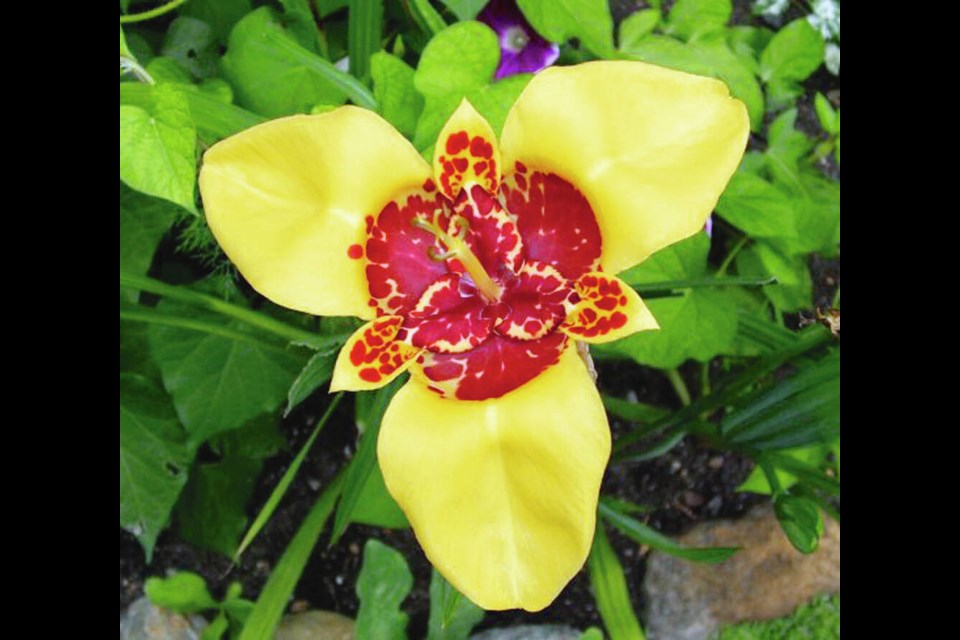I often hear from home gardeners asking about “mystery” plants that have materialized in their gardens. Annual poppy seeds often drift into gardens via birds. Annual flowers that commonly self-sow are the most likely “visitors” in gardens.
A sizeable roster of flowers seed themselves in my garden. They are mainly alyssum, calendula, nasturtium, nicandra (shoo-fly plant), peony flowered poppy (Papaver somniferum), borage, larkspur, and snapdragon.
Some drop-ins are unusual. A few summers ago, a neighbour sent me a photo of a flower she had not planted blooming in her garden. Her “volunteer” was a Tigridia (tiger flower, Mexican shell flower), an exotic beauty painted in flamboyant colours.
Tigridia grows from a tender bulb. Who knows how a flowering-sized bulb found its way into my neighbour’s garden. In most areas the bulbs need to be lifted and stored in frost-free conditions for planting again in the spring.
Perhaps a bulb had lurked in a purchased topsoil applied to the garden in the spring. However it arrived, the flower was a beautiful gift.
This past summer I had my own mysterious drop-in flower when a compact little petunia plant developed at an edge of a vegetable plot housing kale, bulb onions and trellised cucumbers.
When the flowers appeared, of all the petunias I’ve grown in recent years they most resembled Tidal Wave Silver, an All-America Selections and European Fleuroselect award-winning spreading petunia with pale, silvery lavender, dark-veined blooms.
I grow this petunia every year in raised patio containers. It never fails to produce a lovely summer-long show of lightly fragrant flowers, with little care except for regular watering.
But Tidal Wave Silver is a hybrid, very unlikely to self-sow. And it’s not a compact plant like the surprise volunteer.
Plant “species” and petunias. I have, in the past, grown several petunia species, which are more basic, wild plants. Some have self-sown. None were similar to my volunteer plant’s blooms.
Plant “species” are wild plants that have evolved naturally over time in reaction to their environments — unlike cultivated varieties bred by humans to develop specific desired characteristics such as a more compact size, more pleasing flower colour, and early blooming or fruiting.
Species names are binomial; that is, they are two-part. They begin with the “genus” — the basic class of the plant. Examples are Helianthus (sunflower), Salvia, Viola, Zinnia. In normal use in simply naming a plant, the familiar ones are not commonly capitalized. “I potted some violas in September.”
The second part of a species name is a descriptive term designating a characteristic of the plant and separating it from other species in that genus. Examples: Helianthus annus (annual sunflower); Viola tricolor (three-coloured viola); Viola odorata (sweet-scented viola — the sweet violet); Salvia officinalis (refers to the plant’s traditional use in medicine - common sage); Salvia coccinea (scarlet sage).
Animals are also classified in this way, including the modern human species: Homo sapiens (wise, or intelligent, human). Stop laughing.
Next year. My drop-in petunia has inspired me to re-visit petunia species. Two are available currently, from Plant World Seeds (PWS) in Britain. Petunia axillaris is a tough half-hardy perennial with fragrant white flowers. It is sometimes called Rainmaster for its tolerance to rain. It can be grown as a perfumed indoor pot plant.
The other is one I’ve grown before — P. exserrta, a frost-tender petunia with red star-shaped flowers.
PWS also lists a petunia blend of interest. They crossed a selection of modern petunias with the fragrant white P. axillaris to create “Perfumed Shades” The flowers are described as perfumed, and ranging in colour from mauves, purples and pinks to white, with some bicolours and even a smattering of new, novel flower forms.
GARDEN EVENT
Mixing it Up 2025. The Victoria Master Gardeners are hosting their biennial Mixing it Up Conference on Saturday, Feb. 1, 2025, at the Mary Winspear Centre in Sidney. The theme is “Beyond Beauty.” The conference will include five speakers who will share how adding biodiversity creates healthy and beautiful gardens. Topics include urban trees, designing with native plants, citizen science in the garden, and “Mind What You Sow.” For more information on the talks and the speakers, and to register, please go to mixingitup.org or mgabc.org. Early bird fee until Nov. 30 is $75.



